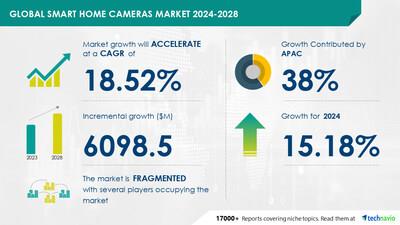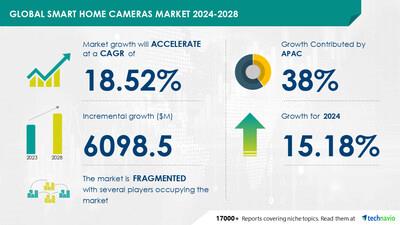
Smart Home Cameras Market Size Is Set To Grow By USD 6.09 Billion From 2024-2028, Innovation And Portfolio Extension Leading To Premiumization Of Products To Boost The Market Growth, Technavio
| Forecast period |
2024-2028 |
| Base Year |
2023 |
| Historic Data |
2018 - 2022 |
| Segment Covered |
Connectivity (Wire-free smart home cameras and Wired smart home cameras), Distribution Channel (Offline and Online), and Geography (North America, APAC, Europe, South America, and Middle East and Africa) |
| Region Covered |
North America, APAC, Europe, South America, and Middle East and Africa |
| Key companies profiled |
56 AI Technologies Pvt Ltd., ADT Inc., Alarm Holdings Inc., Alphabet Inc., Amazon Inc., Arlo Technologies Inc., Comcast Corp., D Link Corp., Deep Sentinel Corp., Frontpoint Security Solutions LLC, Hangzhou Hikvision Digital Technology Co. Ltd., Monitronics International Inc., Resideo Technologies Inc., Robert Bosch GmbH, Samsung Electronics Co. Ltd., Simplisafe Inc., Skylink Group, Vivint Inc., Wyze Labs Inc., and Zmodo Technology Corp. Ltd. |
Key Market Trends Fueling Growth
The global smart home cameras market is witnessing growth due in part to strategic distribution channel expansion. Competitors are broadening their customer base by selling through various channels. An omnichannel strategy, which includes both physical retailers and third-party online retailers, is gaining popularity among home security product manufacturers offering smart home cameras. Notable brands like SAMSUNG and Robert Bosch are increasing their market presence by selling their smart home cameras on popular online shopping portals. This distribution strategy is anticipated to significantly boost the revenue of the global smart home cameras market during the forecast period.
The Smart Home Cameras market in the United States is experiencing significant growth due to increasing population density in urban areas and cultural emphasis on safety and peace of mind. Reliability issues and disruptions continue to be a concern, leading to downtime and potential security vulnerabilities. High crime rates, particularly in densely populated cities, are driving demand for advanced surveillance solutions. Privacy concerns and data protection are also key considerations. Technological innovation, including AI integration and high-quality features like high-resolution video recording and night vision, are important differentiators. The aging population and caregiving needs are also fueling demand for smart home cameras for monitoring elderly individuals. False alarms and threat detection are ongoing challenges, with technology advancements and real-time monitoring helping to address these issues. Regional thefts and burglaries are also major concerns, with smart home cameras providing valuable assistance in property-related crimes. Media coverage and cultural acceptance of connected living and homeownership continue to shape the market landscape.
Discover 360° analysis of this market. For complete information, schedule your consultation-
Book Here!
Market
Challenges
-
The proliferation of counterfeit and low-quality smart home cameras, particularly in developing countries like China, poses a significant challenge to the growth of the global market. Unregistered manufacturers offer equivalent products at lower prices, attracting price-sensitive customers. These players have minimal fixed or regular employment, keeping their operating costs low. This pricing strategy hinders the growth of the market as many consumers in developing economies prefer these low-cost alternatives. The global smart home cameras market faces intense competition from these unorganized players, impacting the market's expansion during the forecast period.
The Smart Home Camera market is experiencing significant growth due to the increasing demand for home security solutions. However, challenges persist in areas such as object detection and image processing, which require advanced technology and computing power. Privacy regulations also pose a concern, with the need for facial blurring and user consent mechanisms. Wireless technology and connectivity infrastructure are crucial for seamless integration with IoT devices and smart home ecosystems. High-resolution cameras, feature-rich cameras with motion detection and two-way audio communication, are in high demand. However, concerns around privacy, data collection, storage, potential misuse, and cybersecurity threats continue to loom large. Companies like Google Assistant, Amazon Alexa, Samsung SmartThings, and Apple Homekit are making strides in this space, offering intelligent security solutions. Improvements in resolutions, low-light performance, viewing angles, and proliferation of indoor cameras and doorbell cameras are key areas of focus. Accessibility and user privacy are important considerations, as is addressing concerns around recorded footage and cybersecurity risks such as hacking and unauthorized access.
For more insights on driver and challenges
-
Download a Sample Report
Segment Overview
This smart home cameras market report extensively covers market segmentation by
Connectivity-
1.1 Wire-free smart home cameras
1.2 Wired smart home cameras
-
2.1 Offline
2.2 Online
-
3.1 North America
3.2 APAC
3.3 Europe
3.4 South America
3.5 Middle East and Africa
1.1 Wire-free smart home cameras-
The Smart Home Camera market is experiencing significant growth due to increasing demand for home security and convenience. These devices allow homeowners to monitor their properties remotely and receive real-time alerts. Major players in this market include Google, Amazon, and Netgear, who continuously innovate to offer advanced features such as high-definition video, night vision, and two-way audio. The market is expected to continue expanding as more consumers adopt smart home technology.
For more information on market segmentation with geographical analysis including forecast (2024-2028) and historic data (2018 - 2022)
- Download a Sample Report
Learn and explore more about Technavio's in-depth research reports
The global Wireless Home Security Camera market is experiencing rapid growth, driven by increasing demand for advanced security solutions. In 2024, the market is projected to grow due to innovations in wireless technology and smart features. Similarly, the global Smart Home Market is expanding with advancements in IoT and AI, enhancing convenience and energy efficiency. Meanwhile, the global Underwater Camera market is benefiting from rising interest in marine exploration and recreational diving.
Research Analysis
The Smart Home Cameras market is experiencing significant growth due to increasing concerns over property-related crimes and the desire for connected living. Advanced technology, such as AI-powered security cameras, night vision, high-resolution video recording, facial recognition, and object detection, are key features driving demand. These cameras integrate seamlessly into the smart home ecosystem, offering real-time monitoring and threat detection. However, concerns over false alarms, privacy regulations, and user consent mechanisms continue to be addressed by manufacturers. Regional thefts and burglaries have received extensive media coverage, further fueling the adoption of these devices. Doorbell cameras and indoor cameras are popular segments, with voice assistants like Google Assistant, Amazon Alexa, Samsung SmartThings, and Apple Homekit enabling hands-free control. Wireless technology ensures easy installation and flexibility. Technology advancements continue to shape the market, with continuous improvements in image processing and threat detection.
Market Research Overview
The Smart Home Cameras market is experiencing significant growth due to the increasing number of regional thefts and property-related crimes. With the advancement of technology, AI-powered security cameras have become an essential component of the smart home ecosystem. These cameras offer high-resolution video recording, night vision, and real-time monitoring, providing homeowners with peace of mind and intelligent security solutions. However, concerns around false alarms, threat detection, privacy regulations, and cybersecurity threats persist. Technology improvements, such as facial recognition, object detection, and image processing, aim to address these concerns. The proliferation of IoT devices and interconnected home ecosystems has made accessibility and control through smartphone applications and voice assistants like Google Assistant, Amazon Alexa, Samsung SmartThings, and Apple Homekit increasingly important. Despite these benefits, privacy concerns, data collection, storage, potential misuse, and recorded footage remain areas of concern for consumers. The United States market, with its high crime rates and large population, particularly in urban areas, is a significant contributor to the market's growth. Cultural emphasis on safety and technological innovation, as well as the aging population and densely populated cities, further fuel the demand for smart home cameras. However, reliability issues, disruptions, and downtime due to internet connectivity and security risks, such as hacking and unauthorized access, pose challenges to the market's growth.
Table of Contents:
1 Executive Summary
2 Market Landscape
3 Market Sizing
4 Historic Market Size
5 Five Forces Analysis
6 Market Segmentation
-
Connectivity
-
Wire-free Smart Home Cameras
Wired Smart Home Cameras
-
Offline
Online
-
North America
APAC
Europe
South America
Middle East And Africa
7 Customer Landscape
8 Geographic Landscape
9 Drivers, Challenges, and Trends
10 Company Landscape
11 Company Analysis
12 Appendix
About Technavio
Technavio is a leading global technology research and advisory company. Their research and analysis focuses on emerging market trends and provides actionable insights to help businesses identify market opportunities and develop effective strategies to optimize their market positions.
With over 500 specialized analysts, Technavio's report library consists of more than 17,000 reports and counting, covering 800 technologies, spanning across 50 countries. Their client base consists of enterprises of all sizes, including more than 100 Fortune 500 companies. This growing client base relies on Technavio's comprehensive coverage, extensive research, and actionable market insights to identify opportunities in existing and potential markets and assess their competitive positions within changing market scenarios.
Contacts
Technavio Research
Jesse Maida
Media & Marketing Executive
US: +1 844 364 1100
UK: +44 203 893 3200
Email:
[email protected]
Website:
SOURCE Technavio

Legal Disclaimer:
MENAFN provides the
information “as is” without warranty of any kind. We do not accept
any responsibility or liability for the accuracy, content, images,
videos, licenses, completeness, legality, or reliability of the information
contained in this article. If you have any complaints or copyright
issues related to this article, kindly contact the provider above.



















Comments
No comment